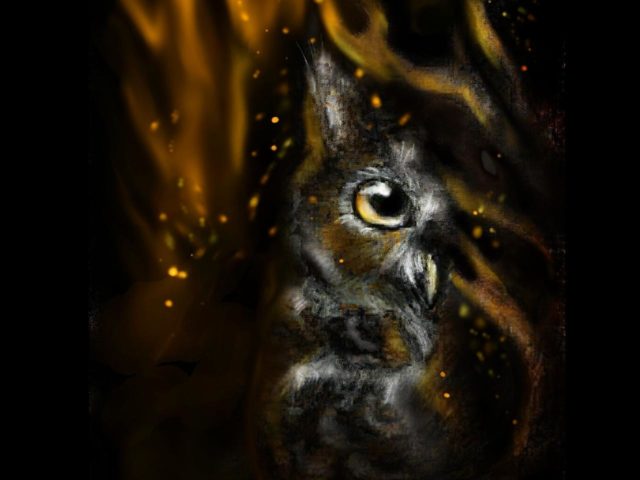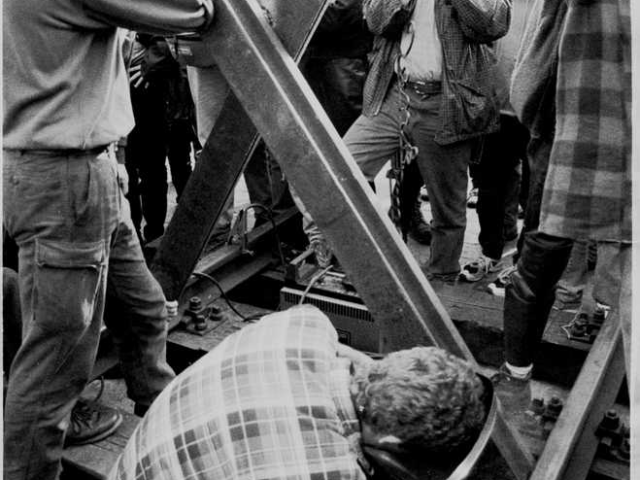FROM CADARACHE TO BURE, STOP THE NUCLEAR MADNESS IMMEDIATELY!
CADAR ACHE: A HUGE ATOMIC FUNFAIR 30 KM FROM FORCALQUIER
On the banks of the Durance is the largest nuclear research centre in Europe. Covering over 1620 hectares there no less than 19 civil and military nuclear installations. For example: a classified secret facility for submarines, a former uranium processing unit, a plutonium production unit, 4 experimental reactors, as well as the highly contested ITER experimental reactor (International Thermonuclear Experimental Reactor) which we are promised could produce, in three decades, unlimited energy without waste (whose budget has increased from 5 to 19 billion euros). The Cadarache site also houses a waste package conditioning centre and a huge storage park that the Nuclear Safety Authority (ASN) deems “unsatisfactory” as “contamination has been measured in the soil and underground water.” In total, there are 42,000 m2 of radioactive waste, part of which is intended to be buried underground at Bure in the Meuse. The risks associated with this site are, to say the least, numerous: in 2009, the Atomic Energy Commission found by chance some 10 kilograms of plutonium that had been mislaid, enough to manufacture 5 Hiroshima-type atomic bombs. In addition to the radioactive and chemical pollution, Cadarache is also located on the most active seismic fault in France. There is also the likelihood that we will soon run out of water to cool all these highly radioactive materials and the risk of fire, due to droughts, increases year by year.
“Why was this harmless centre not simply installed in Paris, and especially in the useless gardens of the Elysee? (…) If I am told that, despite its certified safety, this nuclear centre would cause some danger in Paris and the guests of the Elysee, I will answer that our fate and that of our children present and future are also very dear to us. ” Jean Giono, on the construction of Cadarache, Provence, 1961.
NUCLEAR POW ER A TOOL AGAINST GLOB AL WARMING?
Nuclear energy is often promoted as a solution to the urgent need to reduce emissions. If its production emits little CO2, it can hardly be relied upon to ensure that the plant will remain habitable. Not only does the whole industry, from uranium mining to nuclear waste, gradually contaminate the territories where it is located, but nuclear accidents have condemned many parts of the globe for centuries. With global warming, nuclear power plants will become more and more dangerous. Along the coasts they are very vulnerable to the growing number of storms and to the rise of the oceans. This is likely to interrupt their power supply, as happened in Fukushima in 2011. Heat waves threaten the safety of electronic equipment, as in Fessenheim, in the summer of 2003, when it was necessary to water the walls of the power station with water drawn from the Rhine. In a few years, will there be enough cold water in the rivers to cool reactors? Reactors are already discharging hot water that poses a severe threat to aquatic life during heat waves.
Finally, the promise of an unlimited amount of electricity, made by the nuclear industry when it was launched and that is today made by ITER (see box Cadarache), encourages the development of industrial projects that only increase pollution.
In 70 years, the French nuclear industry has produced 1.62 million cubic meters of radioactive waste, the equivalent of 648 Olympic-sized swimming pools full of matter that will remain highly toxic for hundreds of thousands of years 1 . Each year, it produces 25,000 m3 more. At 30 km from here, 42,000 m 3 of nuclear waste are stored in the gigantic centre at Cadarache where, as the authorities themselves admit, they contaminate the soil and groundwater (see box).
The “solution” decided by the state is to bury the most dangerous waste at Bure, in the north-east of France, a rural region that has suffered from the two world wars and the impact of agribusiness. This gigantic nuclear rubbish dump, dubbed “Industrial Geological Storage Center” (Cigeo), up to 500 meters underground and with 300 km of galleries, should cost at least 25 billion euros of public money (This is certainly only the beginning : we should not forget that between 2007 and 2019 the cost of the construction of the EPR nuclear power station at Flamanville has tripled, rising from 3,5 to 10,9 billion euros.).
The idea seems simple: put the waste in a hole, then close it again. In practice, not only does this not solve the problem, but it creates new ones. First, the rock is not totally waterproof and the rock structures are not stable. This is why in Stocamine in Alsace, following an underground fire, galleries containing chemical waste collapsed, threatening the largest water table in Europe. Another example: to avoid causing an explosion, this waste requires, several hundred meters underground, ventilation on a massive scale: who would be crazy enough to guarantee that there will never be a prolonged power cut over a period of more than a century (See the interview with the nuclear physician Bernard Laponche in Libération, 16/04/19.) ?
We are gathered here today in solidarity with all the people who have come together this weekend in Hévilliers in the Meuse, 600 km from Forcalquier. With them, we say: This pharaonic waste disposal project is not a solution. There is no real solution: the French nuclear policy has led us into a dead end. The least risky option (and infinitely less expensive) would seem to be to store this nuclear waste on the surface in a controllable and reversible way. But above all, above all, we must stop producing nuclear waste.
We must abandon nuclear power immediately. We demand a policy involving the drastic reduction of electricity consumption, a democratic re-evaluation of our needs, a reduced and relocated production. We demand an end to current policies that drive up electricity consumption, such as massive public support for electric cars and big data technologies. From this citadel of Forcalquier, a few hundred meters from the house of Christophe Castaner, Minister of the Interior, we denounce the intense repression unleashed over the past months on those opposing the project in Bure. Since the beginning of 2018, the opponents have faced almost 40 lawsuits in the Meuse alone, 27 prohibitions to be present in the region, a judicial investigation into a alleged criminal conspiracy involving 7 people and that forbids 10 others from entering into contact. Wire- tapping, electronic surveillance of vehicles, dozens of house-searches, these methods infringe the most basic freedoms of demonstration, expression, circulation (See the report by the Human Rights League : « Rapport sur les événements survenus à Bure et sur leur traitement judiciaire », 2019, available on its website).
We declare our solidarity with all those who have the courage to come together to fight against a nuclear horizon presented to us as inevitable. For social justice and ecology, let’s organize ourselves to reject capitalist and industrial excess!
Intercollectif contre les grands projets inutiles et imposés
15/09/2019
Et sinon, la veille
on écrivait ça.

Bure: The return of owls
About the reoccupation of Lejuc wood in July 2019 Two months have passed since the news of the reoccupation of the forest was reported by the media. The violent evacuation immediately followed and ... Lire la suite
14/09/2019
Et sinon, 31 jours après
on écrivait ça.

brochure & manual. Trainstopping -interven...
Exhibition: Trainstopping, Intervening in Rail Transport. Blockade & sabotage of rail traffic in the context of the anti-nuclear movement brochure & manual ==> https://de.indymedia.org/s... Lire la suite
16/10/2019